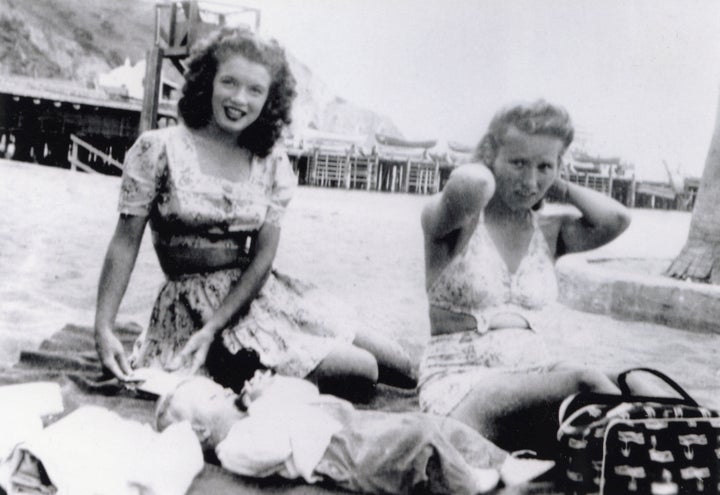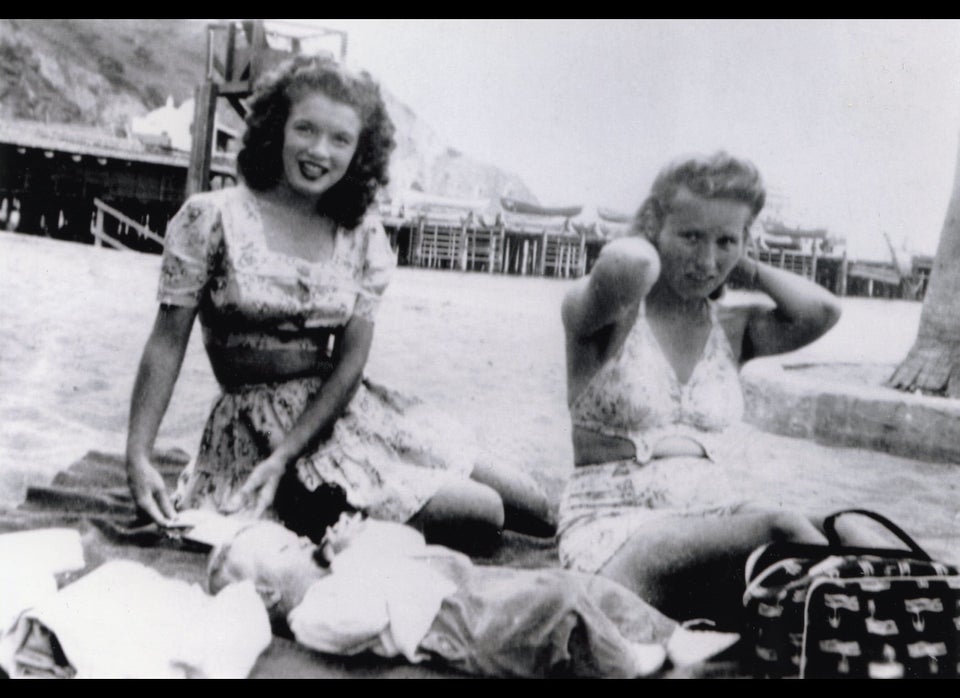
Lois Banner is the author of Marilyn: The Passion and the Paradox (Bloomsbury, $30)
"Persons of genius with mysterious gifts: in many cases a wound has been inflicted early in life, which impels the person to strive harder or makes him or her extra-sensitive. . . Men and women who come successfully out of misfortune, they have strength that is extraordinary." --- Elia Kazan, actor and director, Marilyn's friend and lover
Marilyn Monroe was born Norma Jeane Mortenson in the charity maternity ward of Los Angeles County General Hospital on June 1, 1926.
Her mother, Gladys Monroe Mortenson, was a poorly-paid negative film cutter in a Hollywood editing studio; her father disappeared before she was born. His identity isn't certain; Gladys, sometimes promiscuous, had a husband she was divorcing and a lover she had abandoned when he wouldn't marry her. She suffered from attacks of panic, rage, and depression; she placed Norma Jeane in a foster home shortly after her birth. (She named Norma Jeane after a child she had tended, not after Norma Talmage and Jean Harlow.)
The story of Marilyn's birth sounds like the prologue to a Dickensian tale of victimized childhood or an episode in the saga of Orphan Annie, America's home grown iconic mistreated child, until we realize that in the late 1920s fosterage was the major form of child care for working mothers: day care centers were few and far between and working hours were long. Wayne and Ida Bolender, a mailman and his stay-at-home wife, ran Norma Jeane's first foster home, boarding as many as six children at a time.
They were good parents, although their evangelical religion Norma Jeane her with a fear of sin and the devil. Gladys visited most weekends, taking her to the beach or to Hollywood to see movies.
This mostly positive life ended in 1935, when Norma Jeane was eight. Feeling more stable, Gladys brought her daughter to Hollywood to live with her, but within a few months she had suffered a nervous breakdown. Diagnosed as paranoid schizophrenic, she was committed to a state mental institution in Northern California, where she remained for ten years.
She consigned her daughter to Grace McKee, her best friend at the editing studios. Norma Jeane was sweet, dutiful, and intelligent, but Grace worked full time and had married Ervin "Doc" Goddard, a courtly Texas cowboy who played bit roles in films and had three children living with their mother. Because they might want to move in with Grace and Doc, it was simplest to follow Gladys's example and put Norma Jeane in a foster home. Eventually Norma Jeane lived in ten foster homes between 1935 and 1942, plus a year in an orphanage.
Among other issues, the weak finances of the 1930s caused problems. The Great Depression was in full force. With unemployment at 25 percent, no job was secure. It wasn't unusual for families without means to place their children in orphan asylums or foster homes until they found jobs.
Doc made little money, and Grace lost her job in 1936. But she was resourceful. She persuaded the court to declare Norma Jeane a "half orphan," since her father had disappeared and her mother was institutionalized. That designation required the county to provide a monthly stipend for Norma Jeane's support.
Yet Grace couldn't find a stable home for her ward. The orphanage in which she placed Norma Jeane--The Children's Aid Society Orphanage in Hollywood--was among the best in the city, and the foster families who took in Norma Jeane all contained friends or relatives of Grace. Norma Jeane knew them before she moved in with them.
But most of those families, working class in status, weren't well off financially; some left Los Angeles for other locales and couldn't take Norma Jeane along. In one instance the great flood of 1937 of the Los Angeles River flood destroyed the house of the family with whom she was living, and they all moved elsewhere. Gladys, convinced that she would recover, wouldn't permit her daughter to be adopted.
Norma Jeane didn't like the moving, which often involved moving to a new school. Like most children, she craved stability. She was vulnerable to rejection on other grounds. She was a charity case in an era when taking welfare was considered a disgrace (despite the many families forced by circumstances to do so); she was the daughter of a mother diagnosed as schizophrenic at a time when mental illness was stigmatized as inherited and degenerative; she was probably illegitimate in a period when birth out of wedlock was considered a disgrace.
There is more. She was the victim of sex abuse in two of her foster homes--when she was eight and when she was eleven. Most sex abuse involves fondling, not intercourse, since abusers don't want to leave physical evidence.
Marilyn told photographer George Barris in 1962 that's want was done to her. Jim Dougherty, Marilyn's first husband, claimed that the sex abuse never happened because Marilyn was a virgin when he married her, which was probably true, since full penetration hadn't occurred. We don't know precisely who the abusers were, but circumstantial evidence points to Marilyn's second foster father--a minor film actor who boarded in Gladys's home--and to Doc Goddard, usually a pal to Norma Jeane but who had a rough masculine side. He admitted that he had tried to fondle her one night when he came home drunk.
The experiences of abuse had a tragic impact on Norma Jeane. She began to stutter; she saw demons in her dreams; she became sullen and shy. She blamed herself for the abuse; identified with her abuser; and later developed a case of sex addiction: all are common outcomes of childhood sex abuse. Her personality dissociated; she suffered from post-traumatic stress disorder. According to experts, such abuse has been visited on as many as twenty percent of girls throughout American history, usually by older males.
But Marilyn's Dickensian childhood toughened her. From her earliest years she created a world of fantasy in which she was a famous film star. Thus she accessed what psychiatrists call the human self-care system: the ability to nurture ourselves by spinning fantasies of preferment. Like other historical figures--Abraham Lincoln, Mary Baker Eddy, Eleanor and Franklin Roosevelt, Helen Keller, Ruth Benedict--Norma Jeane turned adversity into strength.
Her path was extraordinary, as she slowly made herself into one of the great photographic models and actresses of the twentieth century--the woman known as Marilyn Monroe. That was the name given to her by Twentieth Century-Fox executives when they signed her to a contract in August, 1946. Marilyn was the chameleon Norma Jeane's greatest alter ego.
She didn't do it entirely on her own. From childhood on she modeled herself on forceful people in her life. Grace Goddard was one. She was sometimes a dark force in Marilyn's childhood, but she was quirky and charming, always laughing and joking, filled with dreams and schemes. She continually told her ward that she would be the next Jean Harlow. Although she did nothing to fulfill her prediction, Norma Jeane's adult personality resembled Grace's. And, in 1938 Grace persuaded Ana Lower, her aunt, to take Norma Jeane in as her foster child, when it became obvious that Norma Jeane was seriously damaged.
A woman of great spirituality and practicality, Ana was a practitioner in the Christian Science Church, functioning as a lay psychiatrist. She brought the force of her personality to transform Norma Jeane, teaching her to access the power of God's love, to realize that nothing was impossible. Reading Mary Baker Eddy's Science and Health every night with Ana provided Marilyn with an arsenal of positive attitudes to counter her depression and lack of self-confidence and to make herself into a star.
Luck played a role, as it usually does. For example, Norma Jeane was pretty as a young child, but during the hormonal rush of pre-adolescence, when bodies often become awkward, she lost her looks. By the age of ten she had reached her full height of 5 feet, 5 and one-half inches. Tall and gangly, she towered over children her age. She was flat as a stick; she looked like a boy. Then fate smiled on her.
By the age of twelve, as she reached adolescence, she turned into a beauty, in a classic case of the ugly duckling becoming a swan. She developed a voluptuous body and a beautiful, innocent face; she radiated a sex appeal that translated into a radiant photogeneity before the camera.
By the late 1930s, as she reached maturity, the "girl next door," with a voluptuous body and an innocent face became the nation's female beauty ideal. Norma Jeane's look matched the ideal. It was nearly inevitable that she would succeed as a pin-up model.
Becoming such a model was her first step on her quest for stardom. She had, indeed, successfully come out of misfortune, but her road ahead would be long and torturous.
See below for images of the young Norma Jeane:
